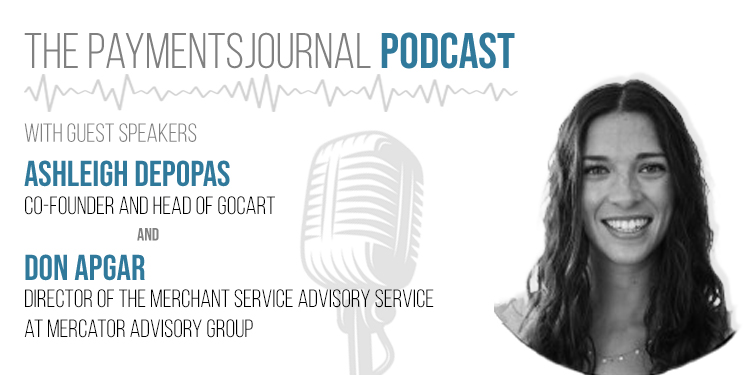Podcast: Play in new window | Download
It is safe to say that everybody has experienced a frictional checkout process at some point in their life. Whether in-person or online, anything interrupting or slowing the checkout process can feel incomprehensibly frustrating. Fortunately, new technology such as GoCart (powered by FIS) can deliver an easy and simple checkout experience without compromising security.
To learn more about how new technology can change and improve the checkout process, PaymentsJournal sat down with Ashleigh DePopas, Co-Founder and Head of GoCart, and Don Apgar, Director of Merchant Services Advisory Practice at Mercator Advisory Group.
PaymentsJournal
Forging a Path to a Frictionless Checkout Process
PaymentsJournal Forging a Path to a Frictionless Checkout Process
Checkout trends worth noting
One rather striking statistic found by GoCart showed that 1 in 4 consumers will abandon payment if they experience friction in the checkout process. Further research by GoCart unpacked some of the reasons behind that figure.
“Folks hate logging in,” DePopas noted. “50% of them cited that they are frustrated when they encounter a moment when they have to create an account or type in a password just to be able to check out.” Naturally, merchants want to generate loyalty through account creation in the hopes that it leads to positive experiences, but consumers still take issue with the process.
The second major reason for cart abandonment was simple distraction. “When forms are long, and when there are too many fields, it is really easy for us to become distracted,” said DePopas. “Consumers don’t like that lengthy process.”
More generally, 77% of consumers want an account that is tied to everything that they use for a payment method. “They want this choice and flexibility of all these different payment methods, and they also want it to be really simple and easy to check out,” DePopas observed. “A lot of times those two things don’t go hand in hand.” These competing desires have led to the popularity of e-wallets like Apple Pay.
This leaves the question: How do you solve for flexibility, simplicity, and security all at once?
Retail is leading the pack in frictionless
Different industries may have different needs and consumer bases, but the wish for an easy payments process is universal. So far, retail has been at the forefront of meeting customer checkout needs. “Retail has set the standard when it comes to consumer expectations around checkout,” DePopas pointed out. “Amazon and Shop Pay have basically set best in class experiences, and now consumers are expecting that everywhere.”
When consumers see the kind of checkout simplicity that is possible, it becomes even more frustrating when other industries fail to keep up. Restaurants have been hit particularly hard with consumer dissatisfaction. Primary pain points used to occur during in-person dining, but due to the COVID-19 pandemic, many restaurants were forced to move into digital channels that had been previously untended.
Digital delivery apps solved several problems for consumers not only by offering the ability to find the food you want, but also providing a streamlined central payment process. “For merchants and restaurants, that’s really frustrating,” explained DePopas, “because they’re actually taking a lot of the margin away from restaurants who are making the food.”
In the healthcare and services sector, there is a slight trend towards digital payments, but the number one issue is still that everything is paper- or check-based. “There isn’t necessarily cart abandonment, because you have to pay for your services,” said DePopas. “But merchants are seeing that it is slower to capture their revenue because it is so high-friction.”
Solving for pain points
Dealing with checkout issues is a tricky undertaking. “Merchants are their own worst enemies,” Apgar suggested. “It’s always a constant balance between fraud and chargeback protection, and taking friction out of the process.” Focus too much on fraud prevention by running loads of consumer data through multiple fraud engines, and you might add an extra second of lag time to a transaction, which makes a difference in a world with lightning-fast expectations.
So what should merchants do? DePopas laid out three different ways companies are solving for checkout pain points and how GoCart can help merchants get there:
- Streamline guest checkout – Simplify the checkout process by removing the need for passwords, long forms, new accounts, etc. GoCart helps recognize users at checkout and let them pay quickly.
- Offer more payment methods – Convenience across channels is paramount, particularly in restaurant and retail. GoCart utilizes pay-by-link capabilities, helping prevent crowding the checkout page from a user experience (UX) perspective.
- Make payments easier across industries and devices – Paying on any device will make for a more positive payment experience for consumers. GoCart’s checkout solutions can be used across industries and are device agnostic.
GoCart also offers embedded one-click payments that support debit, credit, and soon BNPL. “Essentially, [GoCart is] a checkout solution that recognizes the consumer instantly, before they dive into a high-friction experience,” explained DePopas. “We’ve made sure that the experience is cohesive across websites, text payments, email payments, QR code payments… Merchants are exploring so many different ways to sell into different channels that it was really important that we made that checkout very consistent for them.”
The future of checkout
With the industry standard being set in retail, checkouts are going to start shifting towards a standard UX across all verticals – with minor tweaks based on the needs of each industry. “The frictionless, fast, most easy checkout experiences out there are going to be the top players in the space,” DePopas predicted.
Additionally, identity will play a larger role in the checkout process. With GoCart, consumer identity is tied to their different payment methods, aided in no small part by GoCart leading the charge towards embedded payments. “A common checkout path platform like GoCart means that you’re taking a lot of the [verification] burden off the merchant,” Apgar clarified. “That starts to expand the scope of what a common checkout platform is capable of.”
Payment methods will continue to expand to include new products like BNPL and cryptocurrencies, but moreover, merchants will be looking at payments as a strategy to drive revenue and build their customer base. “It’s not unlike how merchants marketed Visa/Mastercard acceptance thirty years ago,” noted Apgar. Checkout providers can also expand their offerings beyond payment methods. “It’s what drives you to consider buying the product now,” DePopas concluded. “That’s a really cool shift for the payments industry in general.”






